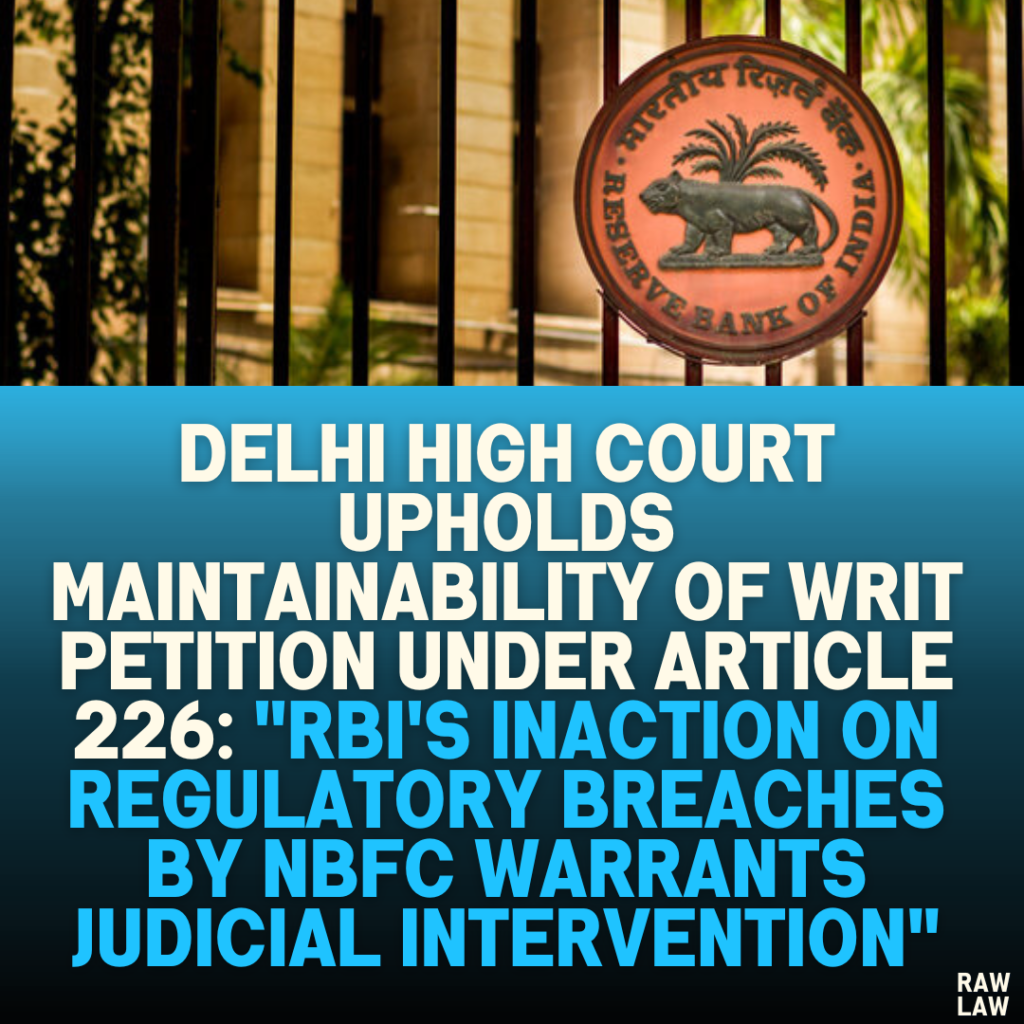Court’s Decision:
The Delhi High Court dismissed the Letters Patent Appeal (LPA) filed by the appellant (ECL’s director) and upheld the Single Judge’s order. The court affirmed the maintainability of the writ petition filed under Article 226 of the Constitution. The petition sought a writ of mandamus directing the RBI to act against alleged financial irregularities and regulatory violations by the NBFC, M/s Exclusive Capital Limited (ECL). The High Court also ruled that the Single Judge was justified in issuing interim directions to the RBI while deciding on the maintainability of the writ.
Facts:
- Company Background:
- ECL, a Non-Systematically Important Non-Banking Financial Company (NBFC), issued Optionally Convertible Debentures (OCDs) worth ₹315 crores to investors between 2021 and 2022.
- These OCDs were later converted into Compulsorily Convertible Preference Shares (CCPS) through a resolution passed in September 2022 to restore ECL’s leverage ratio.
- Minority Shareholder Complaints:
- A minority shareholder alleged that the conversion of OCDs to CCPS was not bona fide and amounted to oppression.
- The National Company Law Tribunal (NCLT), in May 2024, found this conversion oppressive and observed that the funds were being siphoned by the management.
- Judicial Appointments:
- NCLT appointed a former judge as the administrator to oversee ECL’s affairs.
- The National Company Law Appellate Tribunal (NCLAT), however, modified this order and appointed the administrator as an observer while preserving the suspension of ECL’s board.
- Writ Petition:
- The respondent, who purchased CCPS worth ₹175 crores, filed a writ petition under Article 226 alleging the RBI’s inaction regarding regulatory violations, such as breaching leverage ratios and unauthorized issuance of OCDs.
- Single Judge’s Interim Order:
- The Single Judge held that the RBI had failed to exercise its statutory powers and directed the regulator to investigate ECL’s affairs.
- Appeal Before Division Bench:
- The appellant challenged the Single Judge’s order, arguing that the writ petition was not maintainable and that the interim directions overlapped with NCLT/NCLAT proceedings.
Issues:
- Was the writ petition maintainable under Article 226 despite pending proceedings before NCLT and NCLAT?
- Did the Single Judge exceed jurisdiction by issuing interim directions while adjudicating maintainability?
- Did the RBI fail to fulfill its statutory obligations under the RBI Act?
Petitioner’s Arguments (Appellant):
- The writ petition was not maintainable as the relief sought fell exclusively under the jurisdiction of the NCLT/NCLAT.
- The Single Judge improperly adjudicated on merits while addressing the maintainability of the writ petition.
- Interim directions issued by the Single Judge went beyond the scope of relief sought and overlapped with ongoing NCLT/NCLAT matters.
- The petitioner (respondent in the appeal) lacked locus standi as the CCPS purchase occurred after the alleged violations.
Respondent’s Arguments:
- The RBI, as the primary regulator of NBFCs, is the only authority competent to address violations under the RBI Act.
- Reliefs sought in the writ petition could not be granted by NCLT or NCLAT as they lack jurisdiction over RBI’s powers.
- The RBI’s failure to act on repeated complaints constituted a breach of its statutory duty, justifying intervention through a writ of mandamus.
- The writ petition was maintainable as it sought reliefs beyond the purview of the NCLT/NCLAT.
Analysis of the Law:
The court emphasized the statutory powers vested in the RBI under Chapter IIIB of the RBI Act, including:
- Removal of Directors: Section 45-IE allows the RBI to supersede the board of an NBFC if it operates in a manner detrimental to public or depositor interests.
- Special Audits: Section 45MA empowers the RBI to conduct special audits of NBFCs.
- Enforcement of Compliance: RBI regulations mandate NBFCs to maintain leverage ratios and seek prior approval for issuing certain financial instruments.
Despite clear findings of regulatory violations—such as unauthorized OCD issuance and breach of leverage ratios—ECL continued to operate without corrective action from the RBI. The court held that the RBI’s inaction warranted judicial scrutiny.
Precedent Analysis:
The court relied on the Supreme Court’s ruling in CAG v. K.S. Jagannathan, which established that:
- A writ of mandamus can be issued to compel public authorities to exercise statutory powers when they fail to act.
- High Courts under Article 226 can direct public authorities to perform their duties in cases of inaction or arbitrary exercise of discretion.
Court’s Reasoning:
- Maintainability of Writ Petition:
- The relief sought—directing the RBI to act under the RBI Act—was beyond the scope of the NCLT/NCLAT.
- As the RBI is the primary regulator of NBFCs, its inaction created a cause of action under Article 226.
- Single Judge’s Jurisdiction:
- The Single Judge’s interim directions were protective measures to prevent further harm to ECL’s corpus.
- The court clarified that issuing interim directions while deciding maintainability was within the Single Judge’s powers.
- RBI’s Inaction:
- The court criticized the RBI for failing to act on evident regulatory breaches by ECL, including a breach of leverage ratios and unauthorized OCD issuance.
- It held that public authorities vested with statutory powers have a duty to act, and failure to do so justifies judicial intervention.
Conclusion:
The High Court dismissed the LPA, affirming the Single Judge’s decision on writ maintainability. The court upheld the interim directions to the RBI, emphasizing that regulatory authorities must fulfill their statutory obligations to ensure compliance and safeguard public interest.
Implications:
- Strengthened Regulatory Oversight: The judgment underscores the judiciary’s role in compelling regulatory authorities to act in the public interest.
- Accountability of NBFCs: The case highlights the need for stricter compliance with RBI regulations by NBFCs.
- Judicial Intervention in Regulatory Lapses: Courts can intervene to ensure that regulators like the RBI perform their statutory duties effectively.
By upholding the Single Judge’s directions, the court has reinforced the principle that statutory regulators are not only empowered but also obligated to act against entities violating financial norms.



